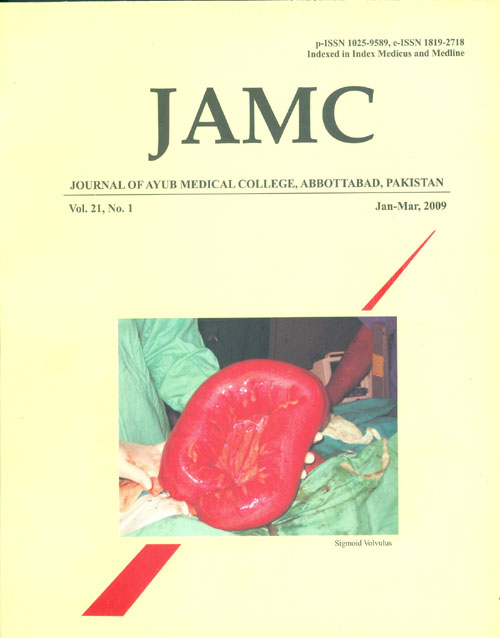MANAGEMENT OF THORACIC TRAUMA: EXPERIENCE AT AYUB TEACHING HOSPITAL, ABBOTTABAD.
Abstract
Background: The incidence of thoracic trauma has rapidly increased in this century of high speedvehicles, violence and various other disasters. It has been observed that chest intubation was required
in more than 75% of patients. Methods: This prospective study was performed in cardiothoracic
surgery unit of Ayub Teaching Hospital Abbottabad from Jun 2007 to Dec 2007. A total of 114
consecutive patients with chest trauma were included in the study, their patterns of injuries classified,
treatment strategies and outcome were recorded on a proforma. Results: Out of 114 patients with
chest trauma, 76 (66.65%) were having penetrating and 38 (33.33%) had blunt trauma. Haemothorax
was detected in 67 (58.77%), Pneumothorax in 23 (20.17%), rib fracture in 11 (15.02%) and
diaphragmatic injuries in 4 (3.5%) cases. Overall complication rate was 14%. Wound infection was
present in 8 (7.01%) and empyema in 4 (3.5%). Mortality was 2.6%. Conclusion: Penetrating chest
injuries were more common than blunt injuries and chest intubation with resuscitation was adequate
in most of the patients.
Keywords: Chest Trauma, Penetrating chest injuries, chest intubation.
References
Ceran S, Sunam GS, Aribas OK, Gormus N, Solak H. Chest
trauma in children. Eur J Cardiothorac Surg 2002;21:57-9 .
Smolle J, Prause G, Smolle-Jüttner FM. Emergency treatment of
chest trauma-an e-learning simulation model for undergraduate
medical students. Eur J Cardiothorac Surg 2007;32:644-7.
Shahani R, Galla JD. Penetrating Chest Trauma. eMedicine J
Available at: http://emedicine.medscape.com/article/
-overview retrieved on 22/01/2009.
Lewis, G, Knottenbelt, JD. Should emergency room thoracotomy
be reserved for cases of cardiac tamponade Injury 1991;22:5-6.
Brown; SE, Gomez GA, Jacobson LE, Scheret McMillan RA.
Penetrating chest trauma: should indications for emergency room
thoracotomy be limited. Am J Surg 1996;62:530-4.
Richardson JD, Miller FB, Carrillo EH, Spain DA. Complex
thoracic injuries. Surg Clin-North-Am 1996; 76:725-48.
Smyth BT. Chest trauma in children. J Pediatr Surg 1979;14:41-7.
Khan MLZ, Haider J, Alam SN, Jawaid M, Malik KA. Chest
Trauma Management: Good outcomes possible in a general
surgical unit. Pak J Med Sci 2009;25(2):217-21.
Farooq U, Raza W, Zia N, Hanif M, Khan MM. Classification
and management of chest trauma. J Coll Physicians Surg Pak
;16(2):101-3.
Brotzu G, Montisci R, Pillai W, Sanna S. Chest injuries. A
review of 195 patients. Ann Chir Gynaecol 1988;77:155-9.
Hanif F, Mirza SM, Chaudhry AM. Re-appraisal of thoracic
trauma. Pak J Surg 2000;16:25-8.
Fallon, WF JR, Wears RL. Prophylactic antibiotics for the
prevention of infectious complications including empyema
following tube thoracostomy for trauma. J Trauma 1992;33:110-7.
Graham JM; Mattox KL Beall AC. Penetrating trauma of the
lung. J Trauma 1979;19:665-9.
Hishberg A, Thomas SR, Bade PG, Haizingav WK. Pitfalls in the
management of patients with penetrating chest trauma. Am J
Surg 1989;157(4):372-5.
Bastos R, Baisden CE, Harker L, Calhoon JH. Penetrating thoracic
trauma. Semin Thorac Cardiovasc Surg 2008;20(1):19-25.
Khan MS, Bilal A. Prospective study of penetrating chest trauma
and evaluation of role of thoracotomy. J Pak Med Inst
;18:33-9.
Eren S, Balci AE, Ulku R, Cakir O, Eren MN. Thoracic firearm
injuries in children: management and analysis of prognostic
factors. Eur J Cardiothorac Surg 2003;23:888-93
Published
How to Cite
Issue
Section
License
Journal of Ayub Medical College, Abbottabad is an OPEN ACCESS JOURNAL which means that all content is FREELY available without charge to all users whether registered with the journal or not. The work published by J Ayub Med Coll Abbottabad is licensed and distributed under the creative commons License CC BY ND Attribution-NoDerivs. Material printed in this journal is OPEN to access, and are FREE for use in academic and research work with proper citation. J Ayub Med Coll Abbottabad accepts only original material for publication with the understanding that except for abstracts, no part of the data has been published or will be submitted for publication elsewhere before appearing in J Ayub Med Coll Abbottabad. The Editorial Board of J Ayub Med Coll Abbottabad makes every effort to ensure the accuracy and authenticity of material printed in J Ayub Med Coll Abbottabad. However, conclusions and statements expressed are views of the authors and do not reflect the opinion/policy of J Ayub Med Coll Abbottabad or the Editorial Board.
USERS are allowed to read, download, copy, distribute, print, search, or link to the full texts of the articles, or use them for any other lawful purpose, without asking prior permission from the publisher or the author. This is in accordance with the BOAI definition of open access.
AUTHORS retain the rights of free downloading/unlimited e-print of full text and sharing/disseminating the article without any restriction, by any means including twitter, scholarly collaboration networks such as ResearchGate, Academia.eu, and social media sites such as Twitter, LinkedIn, Google Scholar and any other professional or academic networking site.










